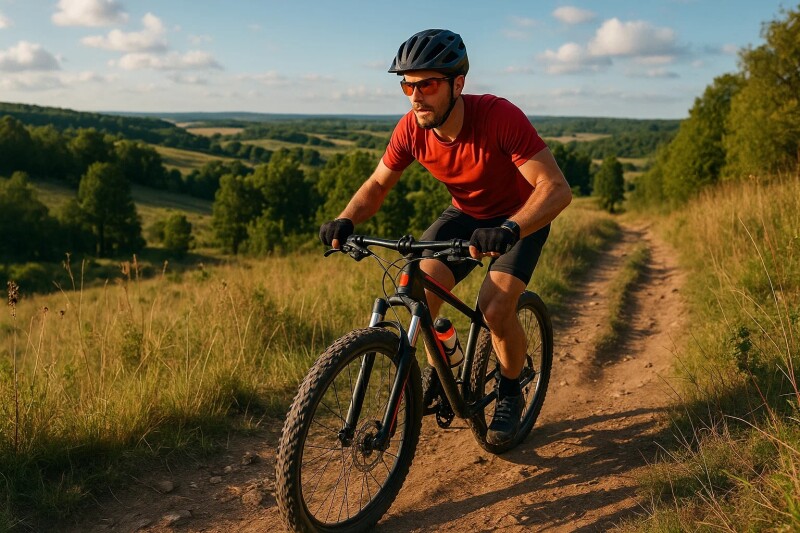[Article]: The Complete Guide to Cross Country Biking: Equipment, Training & Adventure
Cross country biking represents the perfect blend of endurance, technical skill, and wilderness adventure. Whether you're preparing for your first multi-day expedition or looking to upgrade your current setup, this comprehensive guide covers everything from selecting the ideal cross country bike to planning remote trail adventures. Discover how to choose between hardtail and full suspension bikes, pack efficiently for extended trips, train effectively, and navigate safely through challenging terrain.
Types of Cross Country Bikes: Finding Your Perfect Match
The foundation of any successful cross country biking adventure begins with selecting the right bike. Cross country bikes come in two primary categories, each with distinct advantages for different riding conditions and personal preferences.
Hardtail Cross Country BikesAdvantages
-
Lighter weight (typically 1-2 lbs/0.5-1 kg less than comparable full suspension)
-
More efficient power transfer on climbs and smooth terrain
-
Lower maintenance requirements with fewer moving parts
-
Generally more affordable price point
-
Develops better riding technique and line selection skills
Limitations
-
Less comfortable on rough terrain and long descents
-
Reduced traction on technical descents and loose surfaces
-
Higher rider fatigue on extended rough trails
-
Less forgiving of poor line choices
"Hardtails teach you to read the trail and pick clean lines. They make you a better rider by forcing you to use your body as the rear suspension." — Sarah Leishman, Professional Mountain Bike Coach
Full Suspension Cross Country BikesAdvantages
-
Superior comfort on rough terrain and long rides
-
Better traction through technical sections and corners
-
Reduced rider fatigue on extended adventures
-
More forgiving of line choice errors
-
Improved control on technical descents
Limitations
-
Heavier than comparable hardtail models
-
Higher maintenance requirements
-
More expensive initial investment
-
Potential energy loss through suspension movement
"For multi-day cross country adventures, the comfort advantage of full suspension can't be overstated. Your body will thank you on day three when you're still feeling fresh." — Thomas Vanderham, Professional Mountain Biker
Cross Country Bike Comparison by Terrain Type
| Terrain Type | Hardtail Suitability | Full Suspension Suitability | Recommended Travel | Ideal Tire Width |
|---|---|---|---|---|
| Smooth Singletrack | Excellent | Good | 80-100mm | 2.0-2.25" |
| Technical Singletrack | Good | Excellent | 100-120mm | 2.25-2.4" |
| Rocky/Root-filled Trails | Fair | Excellent | 110-130mm | 2.3-2.5" |
| Race Courses | Excellent | Good | 80-100mm | 2.0-2.25" |
| Multi-day Expeditions | Good | Excellent | 100-120mm | 2.25-2.4" |
Ready to Find Your Perfect Cross Country Bike?
Explore our curated selection of top-rated cross country bikes matched to your riding style, terrain preferences, and budget.
Anatomy of the Ideal Cross Country Bike
Understanding the key components of a cross country bike will help you make informed decisions when selecting or upgrading your equipment. Each element plays a crucial role in the bike's performance across different terrain types.
Frame & Geometry
Modern cross country bikes feature lightweight frames with progressive geometry. Look for:
-
Head angle: 67-69 degrees (balances stability and agility)
-
Reach: Longer for stability at speed
-
Chainstay length: 425-435mm for climbing efficiency
-
Bottom bracket height: Lower for cornering stability
Suspension Systems
Cross country suspension prioritizes efficiency and weight savings:
-
Front travel: 80-120mm depending on terrain
-
Rear travel (full suspension): 80-110mm
-
Lockout capability for efficient climbing
-
Air springs for weight savings and adjustability
Drivetrain & Brakes
Modern XC bikes typically feature:
-
1x drivetrains (single front chainring)
-
Wide-range cassettes (10-50t or 10-52t)
-
Hydraulic disc brakes with 160-180mm rotors
-
Lightweight components to reduce overall weight
Wheels & Tires
The standard for cross country bikes:
-
29" wheels for rolling efficiency
-
Tubeless-ready rims and tires
-
Tire width: 2.0-2.4" depending on terrain
-
Lightweight carbon or aluminum rims
Cockpit Components
Crucial for comfort and control:
-
Wider handlebars (720-760mm) for control
-
Shorter stems (60-90mm) for responsive handling
-
Dropper posts becoming standard even on XC bikes
-
Ergonomic grips to reduce hand fatigue
Weight Considerations
Cross country bikes prioritize lightweight design:
-
Race-ready hardtails: 9-11 kg (20-24 lbs)
-
Race-ready full suspension: 10-12.5 kg (22-27.5 lbs)
-
Trail-oriented XC bikes: 11.5-13.5 kg (25-30 lbs)
-
Carbon fiber components for weight reduction
Essential Gear for Multi-Day Cross Country Trips
Proper preparation is crucial for extended cross country biking adventures. The right gear ensures comfort, safety, and enjoyment throughout your journey, regardless of the conditions you encounter.
Real-World Packing List with Weights
| Category | Item | Weight (g) | Weight (oz) | Notes |
|---|---|---|---|---|
| Bike Bags | Handlebar Pack (10L) | 350 | 12.3 | Waterproof; for sleeping gear |
| Bike Bags | Seat Pack (14L) | 410 | 14.5 | Waterproof; for clothing |
| Bike Bags | Frame Bag (6L) | 250 | 8.8 | For food and heavy items |
| Sleeping | Ultralight Sleeping Bag (30°F/-1°C) | 680 | 24.0 | Down-filled for compressibility |
| Sleeping | Inflatable Sleeping Pad | 430 | 15.2 | R-value of 3.0 minimum |
| Shelter | Ultralight 1-Person Tent | 1100 | 38.8 | Alternative: Bivy sack (350g/12.3oz) |
| Clothing | Padded Cycling Shorts (2 pairs) | 320 | 11.3 | Quick-drying synthetic material |
| Clothing | Cycling Jerseys (2) | 280 | 9.9 | Moisture-wicking fabric |
| Clothing | Lightweight Rain Jacket | 230 | 8.1 | Packable, waterproof/breathable |
| Tools | Multi-tool with Chain Breaker | 180 | 6.3 | Essential for repairs |
| Tools | Tubeless Repair Kit | 120 | 4.2 | Plugs, sealant, CO2 inflator |
| Electronics | GPS Device | 100 | 3.5 | With downloaded maps |
| Electronics | Portable Power Bank (10000mAh) | 200 | 7.1 | For charging devices |
| Food & Water | Water Filtration System | 85 | 3.0 | For refilling from natural sources |
| Food & Water | Water Bottles/Bladder (2L capacity) | 180 | 6.3 | Empty weight; add 2kg/70.5oz when full |
| Safety | First Aid Kit | 150 | 5.3 | Compact, bikepacking-specific |
| Safety | Emergency Communication Device | 120 | 4.2 | Satellite messenger recommended |
"The key to successful bikepacking is ruthless minimalism. Every gram matters when you're climbing 2,000 meters on a loaded bike. Ask yourself if each item serves multiple purposes or is absolutely essential." — Lael Wilcox, Ultra-endurance Bikepacking Champion
Never Forget Essential Gear Again
Get our comprehensive cross country bikepacking checklist with weight optimization tips and seasonal adjustments.
Training Regimen for Cross Country Endurance
Preparing your body for the demands of cross country biking requires a structured approach to training. This 7-day training plan is designed to build endurance, strength, and technical skills specifically for cross country riding.
Sample 7-Day Cross Country Training Plan
| Day | Training Focus | Duration | Description | Intensity Level |
|---|---|---|---|---|
| Monday | Base Endurance | 60-90 min | Steady pace ride on varied terrain, focusing on consistent effort and efficient pedaling technique | Moderate (65-75% MHR) |
| Tuesday | Strength & Core | 45-60 min | Off-bike strength training: squats, lunges, core exercises, and upper body work to improve stability | Moderate-High |
| Wednesday | Interval Training | 60 min | 4-6 sets of 4-minute high-intensity efforts with 2-minute recovery periods between each | High (85-95% MHR) |
| Thursday | Active Recovery | 30-45 min | Easy spin on flat terrain or yoga/stretching session focused on hip mobility and lower back | Low (50-60% MHR) |
| Friday | Technical Skills | 60-90 min | Practice cornering, climbing technique, descending, and obstacle navigation on technical trails | Moderate (varies) |
| Saturday | Long Endurance Ride | 2-4 hours | Extended ride on varied terrain similar to your target riding conditions, practicing nutrition strategy | Moderate (65-75% MHR) |
| Sunday | Complete Rest | 0 min | Full recovery day with focus on hydration, nutrition, and mental preparation for next week | None |
Key Training Principles for Cross Country SuccessEndurance Building
-
Gradually increase long ride duration by 10% each week
-
Include terrain variety to simulate race conditions
-
Practice race-day nutrition during long training rides
-
Incorporate back-to-back long days to build resilience
Technical Skill Development
-
Dedicate specific sessions to skills like cornering and rock gardens
-
Practice efficient line selection on technical terrain
-
Work on maintaining momentum through obstacles
-
Develop consistent braking technique for various conditions
"Consistency trumps intensity every time for cross country training. It's better to ride four moderate days per week than to crush yourself once and need three days to recover. Build your engine gradually and the results will follow." — Catharine Pendrel, Olympic Cross Country Mountain Bike Medalist
Take Your Training to the Next Level
Get a customized training plan based on your current fitness level, available time, and cross country biking goals.
Best Navigation Tools for Remote Cross Country Trails
Reliable navigation is essential for safe and enjoyable cross country biking adventures, especially in remote areas. Modern technology offers various solutions to keep you on track and provide peace of mind during your journeys.
Dedicated GPS DevicesTop Recommendations:
-
Garmin Edge 530/830
-
Wahoo ELEMNT ROAM
-
Hammerhead Karoo 2
Best for: Serious riders who need long battery life (15-20 hours), rugged durability, and reliable performance in all weather conditions.
Smartphone AppsTop Recommendations:
-
Trailforks
-
Komoot
-
Gaia GPS
-
MTB Project
Best for: Casual to intermediate riders who want detailed trail information, community features, and route planning capabilities.
Offline Navigation SolutionsEssential Backups:
-
Downloaded offline maps
-
Waterproof paper maps
-
Compass and basic navigation skills
-
GPX files loaded before departure
Best for: All riders as a critical backup system when electronics fail or battery dies in remote areas.
Key Features to Look for in Navigation Tools
| Feature | Importance | Description |
|---|---|---|
| Battery Life | Critical | Minimum 10+ hours for day trips, 20+ hours or replaceable batteries for multi-day adventures |
| Offline Mapping | Essential | Ability to download and use maps without cell service |
| Water/Dust Resistance | High | IPX7 rating or better to withstand rain, mud, and creek crossings |
| Route Planning | Important | Easy creation and modification of routes before and during rides |
| Trail Database | Valuable | Access to comprehensive trail information including difficulty, elevation, and user reviews |
| Emergency Features | Safety Critical | Incident detection, location sharing, and SOS functionality |
"Never rely on a single navigation method for remote cross country rides. I always run a dedicated GPS, have my phone as backup with offline maps, and carry a paper map with key waypoints marked. Technology fails, but preparation doesn't." — Rebecca Rusch, Ultra-endurance Mountain Bike Champion
Navigate with Confidence
Discover the best navigation tools and apps specifically tested for cross country biking in remote areas.
Maintenance Checklist for Long-Distance Cross Country Biking
Proper maintenance is crucial for preventing mechanical issues during extended cross country adventures. Follow this comprehensive checklist to ensure your bike remains reliable throughout your journey.
Pre-Trip Maintenance
-
Complete Drivetrain Cleaning: Degrease and lubricate chain, cassette, and derailleur pulleys
-
Brake Inspection: Check pad thickness (replace if less than 1.5mm), ensure proper alignment, and verify hydraulic systems for leaks
-
Suspension Service: Verify proper air pressure, check for smooth operation, and service if approaching manufacturer's recommended interval
-
Wheel Inspection: Check for true wheels, proper spoke tension, and hub bearing play
-
Tire Setup: Verify appropriate tire pressure for terrain, check sealant levels in tubeless systems, and inspect for cuts or worn tread
-
Bolt Check: Verify all critical bolts are tightened to specification, especially stem, handlebar, and seat post clamps
-
Cable and Housing Inspection: Look for fraying, kinks, or excessive friction in shifting and braking systems
During-Trip Maintenance
-
Daily Chain Lubrication: Apply fresh lubricant after washing or riding in wet conditions
-
Evening Bike Check: Inspect frame for cracks, check for loose bolts, and clean drivetrain
-
Tire Inspection: Remove embedded thorns or sharp objects, check pressure, and top up sealant if necessary
-
Brake Adjustment: Monitor pad wear and adjust as needed for consistent braking performance
-
Drivetrain Tuning: Make minor derailleur adjustments to maintain precise shifting
-
Suspension Check: Verify air pressure and lockout function daily
-
Bearing Assessment: Listen for unusual noises from bottom bracket, headset, or wheel bearings
Essential Tools and Spares for Cross Country Trips
| Category | Item | Weight (g) | Weight (oz) | Usage |
|---|---|---|---|---|
| Tools | Multi-tool with Chain Breaker | 180 | 6.3 | General repairs and adjustments |
| Tools | Tire Levers (2) | 30 | 1.1 | Tire removal and installation |
| Tools | Mini Pump or CO2 Inflator | 120 | 4.2 | Tire inflation |
| Spares | Tubeless Repair Kit | 50 | 1.8 | Sealing larger punctures |
| Spares | Spare Tube | 200 | 7.1 | Emergency backup for tubeless failure |
| Spares | Quick Link (2) | 5 | 0.2 | Chain repair |
| Spares | Derailleur Hanger | 15 | 0.5 | Replacing bent/broken hanger |
| Spares | Brake Pads (1 set) | 30 | 1.1 | Replacing worn pads |
| Consumables | Chain Lube (30ml) | 40 | 1.4 | Daily chain maintenance |
| Consumables | Tubeless Sealant (2oz) | 60 | 2.1 | Topping up sealant |
| Consumables | Zip Ties (assorted) | 15 | 0.5 | Emergency repairs |
| Consumables | Duct Tape (wrapped around pump) | 10 | 0.4 | Emergency repairs |
Pro Maintenance Tip
When bikepacking, clean and lubricate your chain every evening, regardless of conditions. A well-maintained drivetrain is more efficient and less likely to fail when you're far from help. Use a dry lube in dusty conditions and wet lube in rainy weather.
Safety Protocols for Wilderness Cross Country Biking
Remote cross country biking adventures come with inherent risks. Following established safety protocols can prevent emergencies and ensure you're prepared if something does go wrong.
Pre-Ride Safety Planning
-
Research trail conditions and weather forecasts
-
Share detailed route plan and expected return time with someone reliable
-
Study maps to identify bailout points and access roads
-
Check for cell coverage areas along your route
-
Verify local emergency contact information
Essential Safety Equipment
-
Satellite messenger or personal locator beacon
-
Comprehensive first aid kit with wilderness-specific supplies
-
Emergency shelter (space blanket or bivy sack)
-
Fire-starting tools (waterproof matches, lighter)
-
Headlamp with spare batteries
Emergency Response Protocols
-
Stay with your bike unless safety requires otherwise
-
If lost, stop, stay calm, and consult navigation tools
-
For injuries, assess severity before moving
-
Signal for help using three of anything (whistles, flashes)
-
Conserve phone battery for emergency calls
Critical Safety Warning
Never ride remote cross country trails alone without emergency communication capabilities. A satellite messenger device can be the difference between a minor inconvenience and a life-threatening situation when you're beyond cell coverage.
Wilderness First Aid EssentialsFirst Aid Kit Contents
-
Wound cleaning and closure supplies (antiseptic wipes, butterfly closures, liquid bandage)
-
Assorted bandages and gauze dressings
-
Elastic bandage for sprains
-
Pain relievers (acetaminophen, ibuprofen)
-
Antihistamines for allergic reactions
-
Tweezers for splinter and tick removal
-
Emergency trauma shears
-
Blister treatment supplies
Basic First Aid Skills
-
Wound cleaning and dressing to prevent infection
-
Recognizing and treating dehydration and heat exhaustion
-
Splinting techniques for suspected fractures
-
Managing allergic reactions
-
Addressing hypothermia in unexpected weather
-
Proper positioning for shock and trauma
-
CPR and basic life support
-
Evacuation decision-making
"The most important safety tool isn't in your pack—it's between your ears. Good judgment about weather, terrain, and your own capabilities prevents most wilderness emergencies. Pack the right gear, but also know when to turn around." — Kelli Emmett, Professional Mountain Bike Racer and Wilderness First Responder
Embracing the Cross Country Biking Adventure
Cross country biking offers a unique blend of physical challenge, technical skill development, and wilderness exploration. With the right bike, proper gear, adequate training, reliable navigation tools, consistent maintenance, and safety preparation, you're ready to experience the freedom and adventure that only cross country biking can provide.
Whether you're planning your first overnight bikepacking trip or preparing for a multi-day cross country adventure, the preparation is as important as the journey itself. Each ride builds experience and confidence, allowing you to tackle increasingly challenging terrain and more remote locations.
Remember that cross country biking is ultimately about connecting with nature, challenging yourself, and experiencing landscapes in a way that few others do. The right equipment enhances this experience, but the true reward comes from the journey itself.
Start Your Cross Country Biking Journey Today
Explore our selection of cross country bikes, essential gear, and expert-led training programs to prepare for your next adventure.

































Interested? Submit your enquiry using the form below:
Only available for registered users. Sign In to your account or register here.